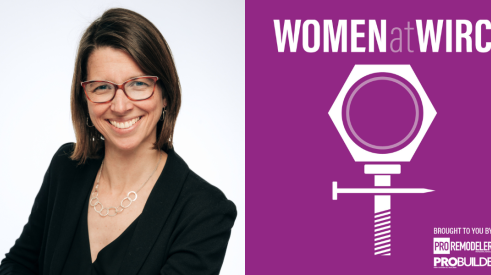|
|
|
|
Tom Swartz |
Do your customers always get what they want? Are they delighted with the finished project? Are they happy to recommend you? If they're not, this is a must read that will help you manage those expectations.
Read the complete discussion below or link to the podcast to listen to the conversation.
Tom: This is Tom Swartz of J. J. Swartz Co. from Decatur, Ill., for Remodelers Exchange. We're going to be talking about managing customer expectations. Today, our participants are Beverly Koehn and Gary Adam, along with Jennifer Dainard. Beverly, tell us a little bit about yourself. You have an interesting background from a standpoint of your experience, which is a little different from a remodeling contractor's ownership. Then Gary, you and Jennifer, where you're from, and then a little bit about yourself, number of employees, how long you've been in business and approximate annual volume. And I'm really interested, Gary, in the number of salespeople in the company besides you.
Beverly: My name is Beverly Koehn. I'm in San Antonio, Texas, and I have a company by the name of Beverly Koehn & Associates. We specialize in enhancing customer experiences and improving sales performance. I've been in the home building and remodeling industry for 23 years now and absolutely love this industry. It's one of the most challenging that I can imagine and each day offers me a new opportunity. I'm also excited because I just published my very first book by the name of, "Loyalty is Love: How to Hold Clients Close for Life," and it's all about how do we get that customer to love us and send us more business.
Tom: Good. Beverly, that sounds exciting. Gary and Jennifer, tell us a little bit about your company in Canada.
Gary: I'm Gary Adam. The company is Pioneer Craftsmen. We're located in Kitchener, Ontario, Canada. That's about 2½ hours east of Detroit. Pioneer Craftsmen is a full-service renovation company. Our volume is $4 million a year. We have approximately 21 employees on staff. My role is president, and I have 35 years of experience in all areas of the renovation industry, from hands-on and starting time right through management. Jennifer will introduce herself. In our company, we have three salespeople who do the design and sales, and Jennifer is one of those key people.
Jennifer: I'm Jennifer Dainard. I've been with Pioneer Craftsmen for a year now. Prior to that I had my own business doing interior design consulting. The interior design aspect of my background is really blending well with the transforming of space and helping people understand how to make their renovation dreams a reality.
Tom: Today we'll talk about managing customers' expectations. Jennifer, with your background as an interior design consultant and dealing with them, along with Gary's expertise, and Beverly's vast knowledge of working with a number of people, I think it will be a great mix. Gary, I'll start with you and Jennifer. Do you have a sales process in place that deals directly with selling expectations for the prospect up front?
 |
|
Gary Adam |
Gary: We have a process which is written, but there can be variations to that. I'll let Jennifer carry that one further. She's been working hard on helping us improve the process and is very good at implementing it.
Jennifer: Usually when someone makes a phone call, we have Lisa answer the phone and take the important information, which gives us a clue so we can be prepared to understand what they're looking for and make sure they've really thought through the process. That can bring us to whether I decide that I go directly to their home and get to know them there. Sometimes the best way to get to know them better is to have them into our offices first. If someone approaches a project that sounds very ambitious and they've never done it before, I want to help them understand what they're about to get themselves into and also if they're being realistic with their budget and their expectations. There are some situations where I find that the best way to get to know them better is to have them come into the office first. We run through a PowerPoint presentation about who we are as a company and what we bring to the table. That really starts to get the ball rolling.
Tom: That sounds good. Beverly, what do you see as some of the good processes for setting the expectations for the prospect right upfront?
Beverly: One of the best things you can do is make sure you spend enough time interviewing a customer upfront. Not only allowing them to interview you, but you interview them to make sure that there is a match there between what they are expecting and what you'll be able to deliver. One of the things that I see in the business that is very detrimental to a relationship is that, especially in changing economies such as the one some of us are experiencing now, we allow our emotions to override our — what we call in Texas — gut instincts. Of course, many times that intuition that you have about an individual is a very strong indicator of whether that relationship is right for you. I think that it's important that you listen to that. The other important thing is that, if you're up front in asking the qualifying questions in your process in the interviewing opportunity, see what that someone is really looking for. For instance, how they grade your quality. If they say they're looking for someone to deliver exceptional quality, what does that mean to them? Tom, as you know having been in this business for a long time, you're evaluation of quality and the customer's evaluation are usually two different things. It's very important that you get on the same page right up front with that.
Tom: Is there a fine line you walk regarding selling realistic expectations without turning the customer off before they decide to go with you?
|
|
|
Beverly Koehn |
Beverly: There is a fine line, Tom. One of the best ways that we can do that is to remember that any time you ask a question of a prospect, that you ask it in terms of what are the benefits to them of your having somewhat of a regimented process in place. If you have a procedure that you cannot give them up front a defined deliver date — let's say it's going to be 30 days out before you'll be able to give them that defined delivery date — the customer keeps pushing you on that. The best way to get them to understand that it's in their best interest to do it is that if you were to give them a delivery date up front without having some of those uncontrolables under your control, then they would be the ones who would lose. They would be expecting something that you would not be able to deliver. If you have someone who keeps pushing you on that point, it's best that you find a way to exit very professionally from that. This can be done by saying that they certainly have a great idea in mind, but your business model would not be able to deliver to their expectation. Perhaps you could refer them to someone else.
Tom: Gary and Jennifer, how would you answer that? Is there a fine line you walk regarding selling realistic expectations without turning the customer off before they decide to go with you?
Gary: There is always walking on a fine line with a client. When a client has expectations that may be unrealistic to our company, we try to have an understanding of why they're looking for a completion date that seems to be out of tune with what we may be able to deliver. It may be a family function they're going to be hosting at their home. We now would have an understanding of why they need it and if we're able to meet that expectation. If we can't, that is the time to bow out rather than create conflict and heartache. We try not to bow out. That job is our bread and butter. We find out what we can do to meet that client's expectations within our company; who can we call on in the company to pull that job together and complete it on time? If not, we just have to say we're very sorry but we won't be able to deliver and wish them luck with your other contractor, whomever they choose.
Tom: Jennifer, do you have anything regarding meeting the expectations without turning them off, in terms of qualifying them on the phone or during the first visit?
Jennifer: I think that letting them know that you're really listening to them is a really big deal. We want to help them feel important. We present them in a really clear way how we approach it and understand how we can fit their expectations, knowing that we've listened to all their parameters and have taken into consideration everything that is important to them in proceeding. Sometimes it comes down to telling a story about a previous client, trying to make them understand the peripheral things. We make a little sale on how we approach it. Think of it in a different context. I find I'm explaining the same thing differently toward finding a way that fits that person's understanding. That's the way to do it without tuning them off. Certainly, if they're a client that we really want, you have to find a way to communicate with them and find their technique and their process so that you can be that match, and if we're not that match, then we're going to back it.
Tom: How do you keep the customer's expectations on track during the remodeling process?
Jennifer: Letting them know what a roller coaster ride it is. Instead of sugar coating it, and saying, "You're going to love it, the end of the tunnel is over here." But, you still have to make them very aware that there are highs and lows. There will be times when it feels like nothing is happening, but it is. You need drying time, etc; make them aware of that type of thing. Problems arise. Address them quickly, in a manner that helps them feel that they're being listened to. We had a client that, in the in the midst of a renovation for a kitchen in a home in the Heritage designated area of town. We had proposed that we do a tin ceiling treatment in their ceiling, but we were using fabricated panels that weren't tin as they were going to be painted. He saw it halfway done, panicked and called and said, "This is crazy; this is horrible. It won't look anything like a real tin ceiling. I see seams." I was able to say that I understood where he was coming from: "You are seeing something that is not yet completed. I still have this, this and this to do to it yet. When you see the final product, you will find that it does fit what you have in mind. If you can have a little more trust and patience in our process and get to the end at a point in which you can say 'it's great.' And if not, I'll tear it down and make it right for you." I think giving them the confidence in those areas really helps keep things moving forward. Once that was over, he didn't question anything anymore.
Tom: What I just learned from that example is that next time someone asks for a tin ceiling, you would explain to them what that tin ceiling is going to look like halfway through the construction part of it. You can set their expectations ahead. "You're going to think it won't be right, but let me show you a picture of the finished product." They may learn from that. Beverly, the expectations sure are high at the beginning, and seems like they could fall if you don't work on that. What do you do to keep the expectations on track during the remodeling process?
Beverly: One of the things I see happening a lot is we're so meticulous at the beginning at covering all the schedules and having a great pre-construction conference — explaining what is about to happen and getting everybody ready to begin and start this exciting journey — and everyone is sort of on a high. Then, as Jennifer said, and very rightly so, we get on this roller coaster. Off we go, and we start the highs and lows. Unfortunately in some situations the lows are so low that they override the highs. If we could always remember that in the beginning we have some very disciplined schedules and agendas that we follow, we go over all those things with the customer. What I see happening after that point is that, every time we meet with the customer, we sort of hit and miss. We'll talk about what the most urgent thing at the moment is, or if they call us we cover their concern. But we don't stick to any type of agenda or process at that point. One of the things I like to do is before we meet with a customer and deal with the concern, think about what your agenda is for that meeting. You can sit down and jot some notes: "First, I want to review where we are at this point. All of the things we told you we were going to do — where are we at this point in time." Then, set the agenda for what you want to cover in that meeting, and make sure you cover those points. Before you leave that meeting get confirmation that you have, in fact, answered all of their questions at that point. Then set an agenda for that you're going to do the next time you meet. Every time you meet with your customer, you're building momentum.
Tom: How often do you hold these meetings, Beverly?
Beverly: I see them at least once a week. If not in person, than via telephone. In some situations, if there's some distance, if they're traveling, by e-mail. I think at least once a week. If you're in front of people and you're continuing through a line with the expectation that you set in the beginning, they're going to be much more satisfied. And they feel like you really care about them and you're keeping them on track.
Tom: Beverly, in managing the customer, is this a one-person responsibility as the salesperson, or is it a total team effort? I want your thoughts on how far that goes. Sometimes it may be that the owner in small firms is the salesperson and the person who does the work, or whatever.
Beverly: I see it as a total team effort. However, I think there should be one central point of communication. Whoever that central point of communication is, it is their responsibility to inform all the other team members of what that expectation is and what the intricate details of that customer relationship are.
Tom: Who do you see that central point of communication being in a general full line room addition or some kind of renovation project?
Beverly: I think it's normally the sales consultant. It may be the project manager, but in most situations it is the salesperson.
Tom: Your advice is that one central point of communication is important. It may be the salesperson or production manager, but then make sure that the communication is to the whole team.
Beverly: Absolutely. You're only as good as your weakest link. If one of the links in your chain is uninformed, they have the ability to disrupt the entire process.
Tom: Gary, what are your thoughts about managing the customer? Is it one person that watches over that customer throughout the project, or is it a total team effort?
Gary: 100 percent, it's a team effort. I agree that the salesperson is the key communicator, yet we always designate the lead hand to be the on-site communicator with the client to keep them informed during the various stages of progress during the day, what's going to be happening the next day. It's a daily process from that lead hand versus the once or twice a week from the salesperson. By having that lead hand who is comfortable in communicating with the client daily, we are able to catch problems before they become an issue. If it's a client concern, address it right away. As part of the teamwork, hold a weekly all-staff meeting that each person rates the client's satisfaction of their project at that meeting. If there is a client who is not happy, everyone here can say, "How can I help?" right from administration to the labor. What is it that we need to do to get that client back up into a delighted client status? That's where the teamwork part comes in; for everyone to be aware of what status the project is at and where help is needed.
Tom: If it's a team effort as you say, how do you institute the proper attitude company-wide? You do that on a weekly basis where everyone comes and talks. Do you talk about each one of your projects at that meeting?
Gary: Yes. The lead hand reports on the project, whether it's on schedule and any issues he may have, any delays, etc. The last comment is client satisfaction. We will be handling approximately 8–10 jobs at a time. It gives everyone within the company something to strive towards 'cause they're among their peers and they have to give a report as to why the client is unhappy. Or, which they're much happier to say, "I have a delighted client. I'm on schedule. The final result is that my client is tickled pink." They love to do that versus saying, "I'm behind!" It gives them a challenge, something to strive for.
Tom: That's good. You're very honest project managers! We sometimes have our guys say everything's just fine, when maybe it's fine, but it's really not fine. You have to have a little confidence in your project managers. Beverly, if it's a team effort as you say, how do you institute the proper attitude company-wide?
Beverly: First of all, it starts with the management, the owner of the company, and, Gary, it sounds like you certainly have the right attitude and have a great person joining you there, Jennifer, who buys into it also. If the manager believes that it's important for everyone to be on the same page, it can be very positive and open and honest without any fear of being chastised in front of the group. I think they're going to do that. The more we can communicate that the honesty helps us to take our company forward, the easier it's going to be for us to make that happen. If people feel comfortable in sharing their ideas and saying, "I have an issue with this customer. I've tried everything, and I just don't seem to be able to communicate," that's someone who really does care about doing a better job. The team members will help that individual pick up the slack. I think that's very important.
Tom: Let me follow up with another question. Are there customers who, no matter what you do, you can't please? How do you avoid them or keep them to a minimum? You know, the customer from hell.
Beverly: I love that question! Interesting that you asked that. I was working with a customer yesterday who was asking me that same question. We have to realize that, in the beginning, we have to identify whether this is the right fit for us. Not every customer is your customer. There are plenty of great people out there. We cannot allow the economy or the bottom line or anything else to redirect our focus away from aligning ourselves only with people who are the right match. There are a lot of signals people give you. Yes, there are some people out there that are just not happy people; they're not going to be happy regardless of what you do. You don't want to allow yourself to get in bed with that individual. The way that you find out is to ask questions up front. For instance, I have a good friend, Dan Bawden in Houston. He has that great list of red flags. Ask very specific quations. For instance: can you tell me about your most recent remodeling experience? What was that like? If you have someone who says it was horrible, the builder, the remodeler was horrible, they never did this, they never did that, and you investigate that a little bit to find out about that experience. They start telling you things that make you think you were being a little too picky over this. That should be a red flag, and you should think very carefully before you accept that customer. One of the things that Dan says that I love is that if you're interviewing a couple, and they're being rude and obnoxious to each other during the interview or during a meeting, why would you possibly think they're going to be better to you and to your people? You have to pay attention to those flags.
Tom: We have a nine question list. I did a little deal at the remodeler's show with it. Basically, it says you have to get to "yes" or identify those things. Some of them came from Dan's red flag list. It is very important that you start from the very beginning, is what I'm hearing from you. Gary, what are your thoughts that? Are there customers who, no matter what you do, you can't please? How do you avoid them or keep them to a minimum?
Gary: Definitely. There is always a client out there that, no matter what we do, they're going to be a difficult client. We seem to run into maybe one a year. Sometimes only one every two years. The first step is that sometimes we create that problem client. In other words, we do not do a few things the way we should have. Now the client becomes visibly upset and concerned and starts to nitpick or hold payment or whatever it is that they feel is their right. Sometimes, it's not just the client, it's us. I won't say that every client from hell was that way. We may have contributed toward it. In identifying that client, I guess as a renovation contractor I think we tend to overlook red flags. First, we may be afraid to ask those questions. It's great to hear that there's a whole list of questions. We've automatically skipped some of those just because we don't want to have that answer. We want the job. I go back to somebody I had asked if they'd had a renovation done before. They said yes. I asked them what they liked about it and asked what they disliked. "Our contractor, he didn't do this, he didn't do that, I wasn't happy with his workmanship, I held money on him, I took him to court." Hearing that, I saw the red flags. In the meantime, I see something else that's been added to the home, and I asked him how that experience was. He said, "Oh, that was an awful experience, they installed the air conditioner. It's noisy and wasn't what I was expecting, and I've taken him to court!" At that point I'm now saying, "OK I'm being told very bluntly this is probably someone I'm not going to be able to work with." We carried the conversation on a bit further, and I asked a few more questions. I was getting answers that were not suitable. Our company was not going to ever please him or their family. At that point I said, "I don't think that we are a good fit for each other. I will wish you luck on this renovation project."
Tom: Gary, with you and Jennifer, we'll talk about the different types of customers. Are the design/build customers harder, easier, about the same or any different to deal with than the customer who calls in — not a design/build, but a remodel or renovation customer? Maybe you're bidding against some other contractor. Do high-end customers have higher expectations, or are they all about the same?
Jennifer: Interestingly enough, sometimes I find that the people who aren't doing as large of a project will be pickier. On the bigger projects, sometimes they're happy to take the whole thing and take the stress off their shoulders. Sometimes on the bigger projects we are looking at higher-end finishes, and they're looking at more quality products that we're putting in. Therefore there's less to draw their attention to they're not happy with how something is coming out. When I meet someone who has worked hard for every dollar and scrimped to get it all put together, and every dime is very important to them. They tend to need to hang over the shoulder of the carpenter and ask a lot of questions and be very finicky. I wouldn't say that it's a clear generalization. I think you get a little bit of everything no matter what. Sometimes they just want to be able to vent. You just need to let them talk it all out, and say, "I'm going to pass this list along." Sometimes it doesn't take more than that to make them happy. They just seem to like to have an element of control and say, "This is what I want." As long as we deliver, things are good.
Gary: In the design/build process, you spend a lot more up-front time with a client learning about their profession, their interests and their family. You're more aware of what issues may become a concern to them. As Jennifer said, it may be due to the finishes on the cabinetry or may have something to do with deadlines or disruption to the family. You now have better insight, and you're able to head that off ahead of time. That's the one advantage of the design/build process. There's a lot more time communicating with the client before the project is priced or the products are selected and delivered.
Tom: You not only get on track with the project, but it sounds to me, in design/build, you get on project a little more on the personal side as well.
Gary: Definitely.
Jennifer: A lot more time spent on rapport and relationship building, for sure.
Tom: Beverly, what is your experience with high-end design/build customers and their expectation of what they're spending a lot of money, versus a smaller kitchen in and out, or bathroom in and out, or a simple room addition that is not necessarily a design/build agreement and all that formal. Do you see any difference in the customer expectations of those two groups?
Beverly: Logic tells me that you would. In reality, it tells me exactly what Gary and Jennifer said. That is, no, there isn't a huge difference. That amount of disposable income that the individuals have and their expectation that is aligned with that are very much the same. A dollar to someone who doesn't have much more than a dollar is as high as someone who has a lot of money and says, "I can afford more, but I expect more simply because I can afford more." I think they're very close to one another.
Tom: Are there any different expectations in specific age groups such as the baby boomers versus younger professionals, age groups and income groups?
Beverly: The only difference in that particular instance would be the method of communication. With some of the aging society, the method of communication is still one where they want to be the more traditional form of communication. If you're working with a young professional, their method of communication is going to be high-tech. They still want that face-to-face time but not as concentrated as the individual who perhaps is in their 60s or 70s.
Tom: Gary and Jennifer, is there an expectation difference between age groups and maybe income level groups, and how do they differ?
Gary: I don't see a lot of difference in the expectations of my clientele, whether they're elderly or well-off or just the working man. As long as we're going to deliver as promised, the important part, as Beverly has mentioned, is the communication and understanding of how that client wants to be involved in the process of the job. Is it daily communication via phone just to reassure them? Is it a lot of extra site visits from the salesperson? They want to be hand-held a little bit more, so when you're talking about the age group 50-plus. They aren't comfortable with the e-mails, and they want answers right away. With the young professionals, we have a whole different way of communicating with them. They may be more tolerant to how fast we respond versus someone in the age group of 50-plus. They want to talk to someone directly and expect that when they call and leave a message that you'll respond within an hour. The tough part is having an understanding of what their expectation is. If you know it up front, then you better deliver.
Tom: We have one more major subject. Gary and Jennifer, questions regarding sales by a non-owner: Gary, you do some sales but you say you have three other salespeople here, as we do. I don't actually do sales. I'm curious about sales by a non-owner — whether that be a sales estimator or representative — do your expectations vary or change when dealing with a sales representative or whatever you call that person? We call them a lot of things: salesman, estimator, sales rep, all those things. Do the expectations change when customers are dealing with a non-owner?
Gary: I have been out of sales for the last two years. I take on past clients to help alleviate the workload from the various sales people here. I've built up rapport with the clients over 30 years, and the trust factor is such that they want to work with me.
Tom: Do all those people that want to work with you get to work with you?
Gary: No.
Tom: That's what I have. They might want to work with me, but I think they're better served working with the smart people like Jennifer and the people who work for me. I'm curious as to how their expectations vary when they're now dealing with a sales-design person rather than who they're used to like the old codger, the old owner, that person.
Gary: I would tend to think that their expectation should not change, but I'm not sure I can answer that question based on my experience as a salesperson. I knew what their expectations were, and I delivered. If I pass a client on to Jennifer, I'm going to give her a heads up on the background of the client and what their expectations are. I expect her then to deliver on that. I think the client is going to have the exact same expectations from me or Jennifer or Jenny or Paul.
Tom: Jennifer, do you agree with that?
Jennifer: I would agree. I certainly haven't had anyone show a different attitude based on the fact that I'm not an owner. I think it's because we come at it with a team approach from the get go. And when we meet clients, I'm not saying, "me, me, me", I'm saying "we, we, we." I think that they're getting the feel that it's more than just me involved, and that they are getting the whole package.
Tom: Maybe the answer is that your whole company approaches it from processes rather than people. And maybe the reason you're having trouble is because you're saying there's no difference in expectations. Beverly, do you ever see when you're dealing with a salesperson who is a non-owner any different expectations that you see the customers having?
Beverly: The only situation where I see that happening is where the owner doesn't have a strong relationship with everyone else on their team, when there is that situation where the customer could call the owner and get a different answer than they would get from the team member. It certainly doesn't sound like that's the approach that you take, Gary, with the ownership of your company and the management with your team. When the owner really gives a lot of authority and accountability to their team members, you don't see a lot of that stuff happening. The customer knows that regardless of who they talk with or who they work with, they're going to get the same consistent answers and delivery of quality. I think that's one of the major keys.
Tom: When it breaks down is when the owner plays "head buffalo" and someone calls him and says they ask him a question, and it's different than the salesperson. The credibility is at risk there, isn't it?
Beverly: Right. If a customer calls you with a concern, before you answer that concern, you're going to consult with your team to make sure you know what the situation is.
Tom: Some people don't. When they don't, that's probably when there's different expectations that come up.
Beverly: Absolutely. That's not a team approach.
Tom: Interesting. One last question, before we go to the summary. Beverly, do we find customers today who want speed, choice and convenience? They want whatever they want fast. Gary mentioned that the elderly people want their answers fast. I was OK until he put elderly at 50, but, Gary, that's OK. I'm over that now. Today the customers also want it at a great value. How do you deliver this in the best possible way with those expectations? I'm talking about speed, choice, convenience, but at a great value. How do you deliver this in the best possible way? How does it differ from customers 4-5 years ago? Beverly?
Beverly: I think that the way you do that is if you continue right up front to help them align their expectations with your delivery reality of what speed, choice and convenience actually entail. If one of those has more value than one of the other three components, you've got a misalignment. Total value is what most people are looking for. They don't know how to put a price point on that. If speed is more important to them than the other two components, it's going to affect total value. I like to do that three-tier approach where we talk about the price being important, but price certainly needs to be a component of total value. This is how we allocate that. This is what convenience factors we will be able to deliver, and these are the choices you'll be able to make. If any of those three are out of line, then that's going to unbalance the value component. We have to do that right up front.
Tom: You're talking to a group of remodelers right now. What advice would you give them?
Gary: My strongest piece of advice for them is that besides doing everything else — we read about construction flow charts, pre-construction conference — is to pick your lead hand carpenter or project manager with the same psychological profile as your client. We're willing to marry that lead hand carpenter with that client. That can give us two people who can communicate together, share some of the same interests. I would not want to put a happy-go-lucky lead hand carpenter with the super serious professor client. They're not going to get along. That's going to create duress during the job.
Tom: That's a very good, thought provoking answer. Beverly, what advice are you going to give the group of contractors out there who are struggling and having problems with their customers and keeping their focus or whatever the case may be?
Beverly: I very much agree with Gary. I would also say that I think it's time we all stepped back and looked at what is our process, because in most situations, we've totally lost it. We need to look at our communication strategy and where the breakdowns are in that communication. In a lot of situations today, people are just so hungry for the job. They're doing just what it takes to move forward and get the signature, and, "That's OK, I'll fix it!" on the back end. As we all know, you can't fix it on the back end. Re-evaluate. Do I have a refined sales process in place and am I following proper steps? If not, I've got to get back to the basics. Selling is not complicated.
Tom: Any last thoughts? Beverly?
Beverly: I think it's remembering that there's no way to over communicate.
Tom: Gary?
Gary: The teamwork approach is a very key item in managing client expectations.
Tom: Jennifer?
Jennifer: Know who your ideal client is. Know how you fit, so it's a match from the beginning.
|
Are your customers' visions in sync with what you deliver?
Add new comment
Related Stories
How to Create a World-Class Remodeling Team
Great remodeling companies position themselves for the future with the right players
Everyone Should Have a Number: KPIs for Your Design Build Team
Measuring key performance indicators guides your team to success while creating accountability and ownership
How to Revamp Your Pre-Construction Process
Experiencing too much slippage and delays? See how Bridget Bacon of Red House Design Build solved these issues by improving the remodeler's pre-construction process
How This Remodeler Revamped Their Pre-Construction Process
Bridget Bacon of Red House Design Build outlines how she helped transform the pre-construction process for improved finances and morale
Building A Small Projects Division from the Ground Up
Through hard work and careful strategy, Harth Home Services has seen big growth
A Mindset of Serving Others
A research study shows surprising results about what makes us take ownership of our work.
3 Keys to Successful Team Management
On this episode of Women at WIRC, hear Laura Burnes delve into her approach to leadership and project management, in addition to sharing insights into Adams + Beasley Associates' winning culture.
4 Steps to Prep Your Business for Contraction
How a remodeling company plans ahead for the worst of times (and the best of times)
Helping Remodelers 'Get Their House In Order'
From remodeler to NARI executive to industry consultant, Diane Welhouse uses her expertise to help business owners














